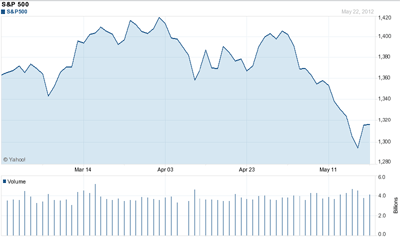While the markets swirl and swoon, it's not time to be trying to grab bargains yet, suggests Jim Trippon of Dividend Genius.
With the recent discouraging news out of Europe and the resulting 7% drop in the S&P, along with the continuing global low interest rate environment, dividend investors, like other retail investors, are concerned about the market.
Add to this the fizzled Facebook (FB) IPO and the general lack of encouraging news, along with the headlines that trumpet that the market downturn “will be followed by selling” (from Reuters and others), and you get the picture. It’s a very uncomfortable market right now to be in.
Some have sold off portions of their holdings, others will sell more. This includes many dividend investors, too, of course, although many other dividend investors like to hold on and weather the market. Some will even boldly or foolishly, depending on either your viewpoint or the given stock, add to their holdings. Others will search out higher yield.
While we certainly understand and know how to hunt for high-yielding dividend stocks—successfully, we might add—we would caution most investors against reaching for yield right now.
Too many investors—some experienced enough to know better—begin their search for yield with a stock screen that pulls out those yielding, for example, more than 8%, 10%, or even 15%. There’s a problem with this, sometimes a huge one. Oh, you can certainly find stocks yielding ultra-high dividends, but there are often difficulties once you look beyond yield.
We’ve seen stocks yielding 15%, 20%, or more, that will pop up on a stock screen where yield is the only criteria chosen. Many—most—of these companies have at best special situations, which can mean that they may be paying out a dividend or distribution that is more than their usual amount. This can skew their yield.
There might be nothing wrong with the company or its underlying fundamentals, it’s just that the yield for the moment is not really representative of the yield you’re going to routinely get as an investor. So watch for that.
Then there’s simply high yield which won’t be sustainable for any number of reasons, usually fundamental ones for the business. The circumstances can vary, yet the stories are invariably similar: the company faces much more stringent competition, it’s had a couple of negative earnings “events,” and has bad business prospects for the future.
Its stock price may have been driven far down, which accounts for the high yield. Or the company is in the process of considering reducing or eliminating its dividend.
We saw the falling stock prices and the elimination of dividends most graphically in bank stocks after 2008 and 2009, though most of those only temporarily blipped up into higher yield territory. The value of the stock and its corresponding dividend was mostly illusory.
A Bad Strategy
When the market plummets and the value of your shares in stocks begins to go down, that’s when you have to have steely resolve to keep to whatever your investing discipline is.
If you are a long-term dividend reinvestment plan (i.e., DRIP) holder, that can be a time to put more money into some solid names that your research tells you will rebound. And although DRIP investing and dollar-cost-averaging is held in contempt by many professional investors, investors who have the patience and the fortitude to pursue this have often built fortunes small and large.
This isn’t the time, though, to try to chase high flyers. The solid payers, such as mega-boring 3M (MMM) and other large, stable names, outperformed the S&P 500 in the rebound from the last financial crisis.
Sure, the market can go down, and you can judiciously trim your holdings even of dividend paying stocks—not a bad strategy to always prune and clean out your holdings from time to time. But you shouldn’t get shaken out of good stocks of good companies, especially those that have been paying you steadily and reliably, maybe for years.
There will be some higher yielding opportunities uncovered, though, even if we have a long correction—suppose it lasts all summer, or even if this pullback ends up being just a short, sharp correction. Some good companies will have their stock prices driven down, therefore their yields driven up.
Now is not the time to panic, but to study and watch and act selectively. And as for high yielders, well, there are some solid ones, but the difference is being able to know how and where to look. Adding these stocks when prices fall can really pay off. Just stay diligent and you will find profitable opportunities.
Subscribe to Dividend Genius here...
Related Reading:
Don't Be in a Hurry to Sell in May






















